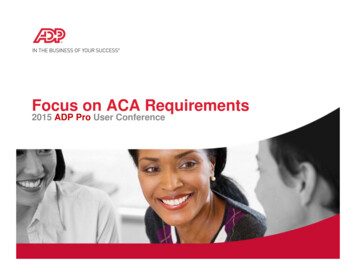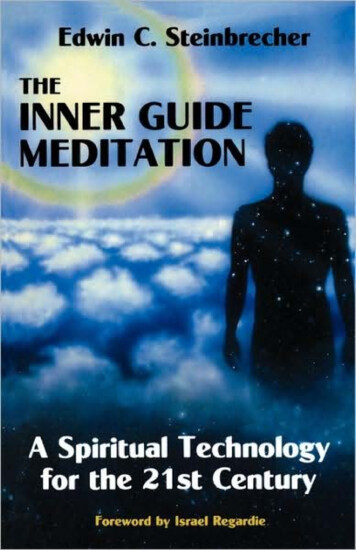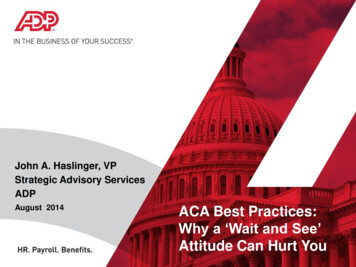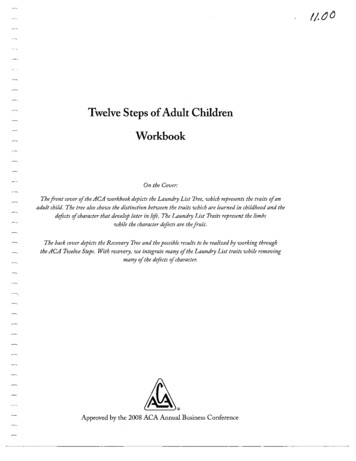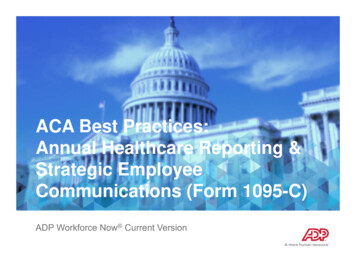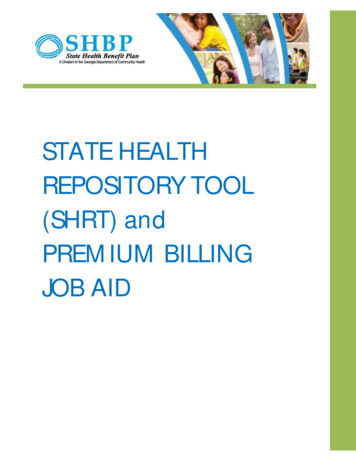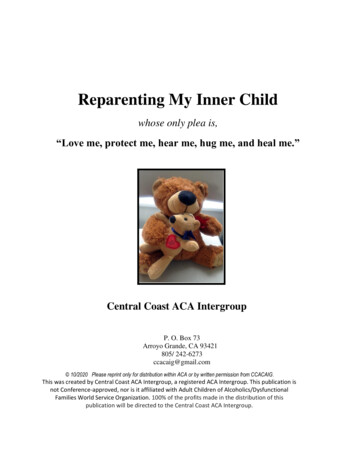
Transcription
Reparenting My Inner Childwhose only plea is,“Love me, protect me, hear me, hug me, and heal me.”Central Coast ACA IntergroupP. O. Box 73Arroyo Grande, CA 93421805/ 242-6273ccacaig@gmail.com 10/2020 Please reprint only for distribution within ACA or by written permission from CCACAIG .This was created by Central Coast ACA Intergroup, a registered ACA Intergroup. This publication isnot Conference-approved, nor is it affiliated with Adult Children of Alcoholics/DysfunctionalFamilies World Service Organization. 100% of the profits made in the distribution of thispublication will be directed to the Central Coast ACA Intergroup.
This was created by Central Coast ACA Intergroup, a registered ACA Intergroup. This publication isnot Conference-approved, nor is it affiliated with Adult Children of Alcoholics/DysfunctionalFamilies World Service Organization. 100% of the profits made in the distribution of thispublication will be directed to the Central Coast ACA Intergroup.TABLE OF CONTENTSIntroductionAcknowledgmentsiiiFROM HURTINGChapter123PageLearn About Dysfunctional FamiliesBuild a Solid Emotional FoundationRealize Your Identity179TO geWhy We Become Our Own Loving ParentsOverview: What Loving Parents Do; What You Can DoLearn to be Your Own Loving ParentLearn to Recognize and Communicate with My Inner ChildMeet Your Inner Child VisualizationWhat Does Your Inner Child Want from You?Building a Relationship with Your Inner Child – TrustBuilding a Relationship with Your Inner Child - CommunicationBuilding a Relationship with Your Inner Child – NegotiationIdentify Experiences That Stunted Your Emotional GrowthLearning to GrieveOverview of Life StagesCompleting Life Stages - Trust vs. MistrustCompleting Life Stages - Autonomy vs. Shame and DoubtCompleting Life Stages - Initiative vs. GuiltCompleting Life Stages - Industry vs. InferiorityCompleting Life Stages - Identity vs. ConfusionCompleting Life Stages - Intimacy vs. IsolationCompleting Life Stages - Productivity vs. StagnationCompleting Life Stages - Integrity vs. DespairInto the Finish LinePeace and 08APPENDICESPageABCMeeting Format when using this WorkbookAnswer Key for Chapter 3 & Chapter 12Fun Things to Consider Doing109112113
IntroductionAdult Children of Alcoholics is a spiritual program based on action coming from love. Our Inner Children arethose precious beings inside who survived childhood without parents that could provide a stable, nurturing, andconsistent environment. In ACA recovery we need to have an ever-present connection to our Inner Children who arepart and parcel of our Higher Power. The Steps give us the framework and discipline for recovery. In ACA we learn thatthe solution to dysfunction is to become our own Loving Parents. As our own Loving Parents, we reach out to our InnerChildren because we are the adults. We review the past from our vantage points of adults and provide the fragmentedchildren inside us with ways to develop: A relationship with us as adultsA solid foundation for natural emotional growthA complete identityA process for grievingA plan to resolve the neglect, abandonment, abuse, and trauma of childhood that stunted ouremotional growth to complete the life stages we did not finish.To do so, we use ACA tools and get the emotional support of our ACA family that will allow us to build healthy,happy, and functional adult lives through ACA meetings that incorporate and emphasize reparenting.A. Our Own Loving Parent MeetingsIn our meetings, we present a question on which to focus to build relationships with our Inner Children. Weshare our experience, strength, and hope on that topic. We read passages in the workbook to reinforce theconcept. We work through exercises about the topic. Then we read through activities we can do in the ensuingweek to work on that aspect of recovery. Following that, we briefly share what we have done this past weekfor our Inner Children as we progress in integrating what we have learned.B.Workbook with Open Sharing MeetingsWorkbook with Open Sharing meetings spend 20 minutes opening the meeting with the readings,announcements, 7th Tradition, and welcoming newcomers. Thirty to forty minutes are allocated to theworkbook. The remainder of the time is devoted to open sharing on any topic. We included a meeting formatat the back of the workbook for the 1.5-hour meeting.C. Workbook-Only MeetingsParticipants in an ACA group may elect to form a separate meeting to concentrate on reparenting their InnerChildren. Workbook-only meetings last for about an hour. Participants typically start and end with the ACASerenity Prayer and use the workbook.Our Inner Child and Inner ChildrenWhen we experience loss, abandonment, abuse, or trauma without emotional support from parents orcaretakers, we fragment. At the extreme end, we split into separate personalities (multiple personality disorder). Moreoften, some of us shatter emotionally into multiple Inner Children, while others psychologically separate into one InnerChild. In this workbook we do not make the distinction between Inner Child and Inner Children. Instead we use the term“Inner Child” to avoid constantly writing “Inner Child(ren).” We do, however, use the term “Inner Children” as theplural form of “Inner Child” throughout this workbook.Exercises are Self-Assessment Inventories and Educational Tools; then the Recovery Work BeginsIn this workbook we focus attention on a topic and provide exercises that guide ACAs to address in theirrecovery work. The exercises are designed to focus the user’s awareness on what to work on. These are mini selfinventories or informational tools. Recovery largely depends on doing the work listed in “Things You Can Do inRecovery This Week” between meetings and sharing insights about the work with Sponsors, program friends, andparticipants at meetings during open sharing.Pacing - Meetings are free to decide how long they spend on each chapter. The work is comprehensive andthorough. Some sections require far more time than others.
AcknowledgmentsJust as Adult Children of Alcoholics recognizes its 12 Step roots in Alcoholics Anonymous, ACA recoveryreaps the benefits of advances made in the therapeutic community. Recovery techniques presented here are based onthe work of many individuals. We stand on the shoulders of giants in using their ideas to progress in our recovery,and we appreciate their efforts that are collectively providing the pathway to our becoming happy, joyous, and freefrom dysfunction.Dysfunctional Families – Claudia Black in It Will Never Happen to Me explored the interplay in alcoholic families(1981). John Bradshaw on: The Family (1986) explored the dynamic in dysfunctional family systems.Emotional Foundations – Logic applied to dysfunctional family systems results in the supposition that childrengrowing up in dysfunctional homes did not complete healthy emotional development. To that end, we propose thatto complete the stages of development that were interrupted, we complete them.Identity Development – In dysfunctional families the children choose or are forced to choose to survive abuse byidentifying themselves as abusers or as victims. These children have no coherent sense of self, no clear identity,having mimicked or accepted the behavior of the perpetrators and/or their victims to survive. In recovery we explorewhat our core values are (what we’d die for), and systematically align our thoughts, words, and behaviors with them.Becoming a Loving Parent to Our Inner Children – Carl Jung explored the notion of a child within us inMemories, Dreams, Reflections. (1962). Eric Berne in Games People Play (1964) laid out his theory ofTransactional Analysis between the various parts of the human psyche – the parent, the adult, and the child. ClaudeSteiner described the adoption of abuse survivors living life according to self-developed dysfunctional scripts inScripts People Live (1974).Lucia Capacchione used the idea of reparenting the Inner Child in her art therapy work in 1976 that she explained inher book, Recovery of Your Inner Child (1991).Charles Whitfield detailed recovery in his book, Healing the Child Within: Discovery and Recovery for AdultChildren of Dysfunctional Families (1987).Listing Traumatic Experiences – We loosely borrowed from Peggy Pace (Lifespan Integration: Connecting EgoStates through Time (2003) the idea to chronologically list traumatic experiences of childhood and included a grid.We added the recognition of joyful events and milestones.Grief Work – Elizabeth Kubler-Ross developed model of five stages of grief. In her book On Death and Dying(1969), she first discussed her theory of the five stages of grief for terminally ill patients.Life Stages – We expanded on Erik Erikson’s psychosocial model of human development from an observationalmodel about life stages discussed in his writing, Identity and the Lifecycle (1959), to using those observations tocomplete each stage of development.Disconnections between Core Beliefs, Thinking, Speaking, and Behavior – Alcoholics Anonymous uses the term“Stinkin’ Thinkin’ to describe confusion in beliefs, thoughts, words, and actions. Eric Berne, in Games People Play,(1964), described this phenomenon as the “critical parent.” Francine Shapiro, in her method to reprograminformation in brain cells, Eye Movement Desensitization Reprocessing (EMDR) developed in 1988, focuses onremoving “false, negative beliefs” and replacing them with true, positive beliefs. In ACA recovery we are rethinkingwhat is real for us and ridding ourselves of the vestiges of ideas we came to adopt in moments of life-threateningabuse and trauma if our efforts to survive. The goal is to align our true beliefs with our thoughts, words, andbehavior.ThanksWe give thanks to our Higher Power. We thank Tony A. and the Alanon children who, too old for Alateen,continued to pursue the connection between their lives growing up in alcoholic homes and their dysfunction. Wethank our program fellows whose shared wisdom allowed us to create this workbook and the WSO LiteratureCommittee that inspired us to improve the original manuscript.
Learn About Dysfunctional Families – Chapter 1Question: How do we become alcoholics/addicts or codependents?ReadingDysfunctional Family SystemsParents in a dysfunctional family include one alcoholic/addict and one codependent, twoalcoholics/addicts, or two codependents. The codependent parents relinquish control to thealcoholic/addict parents, taking on long-suffering roles. Children in dysfunctional families makedecisions of how to survive the family abuse since they cannot escape or fight back. They oftenpattern their lives after the parent-abuser or the parent-victim.Alcoholics or AddictsAlcoholics and addicts are people who misuse substances, engage in behaviors, or adoptbeliefs to dull their pain, escape their feelings, or feel alive. Substances include, but are not limitedto, alcohol, caffeine, drugs, and tobacco. Behaviors may include excessive use of technology ormedia, pornography, sexual abuse of self or others, raging, gambling, risky or dangerous activities,and hoarding. Adopted beliefs may be grandiosity, superiority, and “right” to control, exploit,and/or manipulate others. They Fluctuate between reactive positions:1). I am the victim; you are my savior; he is the perpetrator2). You are the victim; I am your rescuer (and you will owe me for it); he is the perpetrator3). You are the perpetrator who has betrayed me; I am the victim; I will find another SuperHeroCharm others to manipulate them (eye contact, listening, touch, intimate social proximity,compliments, gifts, parental nurturing, and protection)Isolate the codependent from all othersIntimidate codependents with superior education, intelligence, skills, station in life, creativity,etc.Undermine, ignore, minimize, and shame efforts and accomplishments of codependents anddisparage their prideRally codependents to fight causes and quietly enjoy watching the mayhemBait others into arguments and competitions where the addicts have unfair advantage; theymust “win” and others must “lose,” be hurt, or humiliatedErratically create, define, assert, and enforce their constantly changing family rulesDramatize plights to create urgency and allegianceWork the angles (preferring indirect, convoluted, and “quick-fix” solutions)Are hyper-vigilant and unforgiving when THEIR boundaries are violated, using such“violations” to manipulate others.Manipulate codependents (push and pull) with conditional love, abandonment, and violence1
CodependentsAllow or insist others use them or their services, time, skills, creativity and so onBelieve they deserve to be used and abused; it is their roleBelieve they are too afraid, weak, stupid and cede control and responsibilityBecome self-effacing and self-destructive to please abusers and/or avoid abuseTry to read the minds of their controllers to pre-empt outbursts and avoid violence; believe others alsoread their mindsAdopt and champion the opinions, attitudes, behavior, and causes of the controllers to gain theirapproval or avoid abuse of self or othersLive for hints of compliments and recognition from the controllersKeep trying to please their controllers and everyone else because everyone else is more importantSell out or minimize value of other codependentsSuffer in silence, sigh a lot (martyrdom), or whine loudly and “guilt” othersWhen a Family Member Changes BehaviorWhen someone stops playing by the dysfunctional family rules, the family dynamic becomesunbalanced and uncomfortable. As a result, the disrupter who is “making waves” and “ruining” the lives ofeveryone else in that dysfunctional system becomes the person the others try to force back into his/herdysfunctional role by: Escalating control through guilt, abandoning, whining, crying, undermining, threatening Threatening to disown or exile the disrupterReplacing the renegade immediately with a more compliant person to prove how worthless andexpendable the disrupter isAttacking the renegade physically, his/her reputation, or livelihoodLetting Go of Dysfunction - Associate with Functional PeopleAt the beginning of recovery, it may be easiest to step out of the baiting game by staying away ordistancing yourself from all people (relatives, friends, co-workers ) who bring out your dysfunctionalbehavior. When you have learned what your limits are, how to communicate them, how to assert yourself,and to stand your ground, you will no longer feel threatened or be lured into dysfunctional roles and games.As you progress in recovery you will be more comfortable interacting with dysfunctional people becauseyou will know how to handle them and keep yourself safe.Letting Go of Dysfunction - Refuse to PlayIt is not always possible to avoid family members and others you interact with daily who aredysfunctional. Remember that the point of a dysfunctional game is for the one who introduces the game to“win”. The rules of the game ensure that outcome every time. So when a “game” is introduced, the saneresponse to it is to:1. recognize that your adrenaline has increased because you have been baited2
2. see that you are being lured to play the game (understanding that your role in it is to lose)3. refuse to playIf the game is “Rescue Me”, your response might be, “Let me know how you solve that problem.”If the game is “Give Me Your Nifty Thing”, your answer can be, “No, I really enjoy it and treasure itmyself!” The solution to the game, “Let Me Use All Your Time, Ability, Energy, and Resources”, can beto say, “No” or “I’ll have to check my calendar.”Letting Go of Dysfunction - Say NoIf you choose to do things for someone, you need to question your own motives before you committo any action. If you are willing to do it, you ought to be getting something healthy from the transaction.You then need to determine if you have the extra time, energy, and ability to do it. Do not commit yourselfif you have any doubt. Give yourself permission to say, “No.” You might even use this opportunity to setup a reciprocal trade – “I’ll do this one thing if you do this other thing for me first”;without an equal trade no healthy relationship exists.Letting Go of Dysfunction - Decide On, Communicate, and Enforce BoundariesRecovery depends on figuring out who you are, what your likes and dislikes are, and what yourlimits are. Recognizing the feelings of your Inner Child is the easiest, fastest way to figure out what yourlimits are. Once you know what they are, then communicating them to others is essential. Communicatethem, in advance if possible, but definitely when your boundaries have been violated. Others cannot readyour mind; they will not stop violating your boundaries if you do not tell them to stop. If your boundary iscrossed again, you need to immediately act on the consequence you decided on. If the boundary is violatedthe third time by the same person, you need to end the relationship because that person is consciouslyabusing you and will continue to do so. You are not bound by guilt to put up with boundary violations.Letting Go of Dysfunction - Respect YourselfTo become emotionally healthy, you need to make the decision to respect yourself. To do that youfocus on yourself instead of others and become rigorously honest in taking your inventory: who you are,who you aren’t but want to be, what you actually need, and what you want. As your own loving parent, youthen find healthy ways to supply those needs and wants yourself.Letting Go of Dysfunction - Realize Why You Do What You DoBecoming aware of what you do allows you to look at why you do it. You are then able to traceyour dysfunctional behavior to old messages (stemming from childhood instances of abuse, neglect,abandonment, loss, and trauma), silence the messages, and resolve the issues. Then you will act moreappropriately in daily interactions and respond rather than react to dysfunctional people and life disruptions.3
Exercise – Identify Characteristics of Addicts and CodependentsList 3 – 5 characteristics of an alcoholic/addict and 3 – 5 traits of a codependent. Share your answers with membersof your 4.5.5.Exercise – Identify the People in Your LifeBelow each gingerbread person, write the name of 3-6 people you interact with regularly. Write an A on the chest ofthe gingerbread person if your person has alcoholic or addiction characteristics. Write a C on the chest of thegingerbread person if your person has codependent traits. Share with members of your group one or morealcoholic/addict or codependent characteristics each person exhibits.4
Exercise – You Might be an Alcoholic or AddictPut a checkmark next to all the items that are true for you. Share with members of your group one or more alcoholicor addictive characteristics you see in yourself. 123 I misuse substances, engage in behaviors, or adopt beliefs to dull my pain, escape my feelings, or feel alive.I misuse substances such as alcohol, drugs, caffeine, or tobacco.I engage in excessive use of technology, media, pornography, sexual abuse of self or others, raging, gambling,risky or dangerous behavior, or hoardingI am greater than and superior to others.It is my job, my responsibility, to control and use others and make them do what I want them to.I variously take on the position of victim, savior, or perpetrator to manipulate others; I assign the roles to others.I charm others to manipulate them using eye contact, listening, touch, social proximity, compliments, gifts,parental nurturing, and/or protection.I like to isolate the codependent from all others.I deliberately overwhelm codependents with my superior education, intelligence, skills, station in life, creativity,etc.I undermine, ignore, minimize, and shame the efforts and accomplishments of codependents and disparagetheir prideI get codependents to fight my causes and quietly enjoy watching the mayhem they createI bait others into arguments and competitions where I have the advantage; I must “win” and others must “lose,”be hurt, or humiliatedI erratically create, define, assert, and enforce my constantly changing family rules; it keeps others off balance.I dramatize plights to create urgency and allegiance to get others to do what I want them to do.I work the angles (preferring indirect, convoluted, and “quick-fix” solutions) to solve my problems.I am hyper-vigilant and unforgiving when my boundaries are violated, I make others feel guilty by reminding themwhen they violated my boundaries so they will do what I want them to do.I manipulate codependents (push and pull) with conditional love, abandonment, and violence.4567891011.12.13.14.15.16.17.Exercise – You Might be a CodependentPut a checkmark next to all the items that are true for you. Share with members of your group one or more codependentcharacteristics you see in yourself. 12345I allow or insist others use me or my services, time, skills, creativity I believe I deserve to be used and abused; it is my roleI believe I am too afraid, weak, stupid , so I give up my control and responsibility to stronger peopleI become self-effacing and self-destructive to please abusers and/or avoid abuseI try to read the minds of addicts and alcoholics to pre-empt outbursts and avoid violence; I believe others readmy mind, too6I adopt and champion the opinions, attitudes, behavior, and causes of my alcoholic/addict to gain his/herapproval or avoid abuse for myself and/or othersI live for hints of compliments and recognition from my addict/alcoholicI keep trying to please my alcoholic/addict and everyone else because everyone is more important than meI sell out or minimize value of other codependents like meI suffer in silence, sigh a lot, or whine in the effort to make my alcoholic/addict feel guilty789105
Things You Can Do in Your Recovery This WeekShare your insights and feelings about this chapter’s information and exercises as well as the activities below withyour sponsor, a program friend, and/or participants at a meeting. Ideally, over time, you will work through all theunresolved issues addressed in this chapter.Read through each scenario given. Group participants take turns answering the questions in the third column.ScenarioYou break the family rules and everyonein the family pressures you to act likeyou always have.You are around dysfunctional familymembers, neighbors, co-workers, andacquaintances.Breaking the Family RulesIn Recovery I Can Do ThisWhat can you do to stop being forcedback into dysfunctional behavior?Associate with Functional PeopleWho can you be around who is safe andfunctional?Refuse to PlayWhat can you do instead of playing adysfunctional game?Someone tells you how much he needsyour help.Just Say NoA meeting secretary asked you to lead ameeting. You start reading through themeeting format, but the meetingsecretary keeps interrupting you. Youfeel like you have been set up for abuseand betrayed.Enforce BoundariesAsk yourself:Do I want to help?Why do I want to help (right thing todo, codependence, or gain anadvantage)?Do I have the extra time, energy,ability, and resources to help?What can you say respectfully to themeeting secretary to stop the boundaryviolation?You help others a lot. You do not standup for yourself. You allow others to useand abuse you. You do not like yourselfor your life.Respect YourselfYou feel adrenaline pumping becauseyou have been baited to play adysfunctional game that you will lose.You name the lure that got yourattention. You refuse to play.Recite and live the ACA Serenity PrayerAnswer these questions:Who are you now?Who do you want to be?What do you need that you do not have?What do you want that you do not have?List and prioritize your unmet needs andwants and then supply them.You gave your friend the money yousaved up for 6 months to go on vacationbecause she said she needed it to payher rent. Instead, she bought newclothes “for job interviews” with thatmoney and slept with the landlord to“pay” the rent.Realize Why You Do What You Do6Answer these questions:How do you feel?What event in your childhood made you feellike this?What can you do to resolve your feelings aboutthe childhood event?What can you say or do to resolve your currentproblem with your friend?
Build a Solid Emotional Foundation - Chapter 2Question: How do I build a strong emotional foundation for my Inner Child?ReadingWith a strong, solid emotional foundation, our Inner Children can grow up emotionally.Without it, we keep building our lives on shifting sands and wondering why we fail.In recovery, Loving Parents ensure that their Inner Children get all their physiolocial, safetyand security, loving and belonging, esteem, and actualization needs met.Exercise – How I Provide my Inner Child with a Solid Emotional FoundationIn column 1, circle any item listed that your Inner Child is getting enough of from you. In column 2, note those itemsnot circled in column 1. In column 3, write your plan to supply it. Example: You circle everything except “sleep” incolumn 1. In column 2, you jot down “sleep.” In column 3, you decide to stop drinking coffee after 10 am daily.Inner Child’s NeedsBasic Needs My Inner Child LacksPhysiologicalClean Plentiful ty & SecurityMindBodyEmploymentResources to live comfortablyHealthWorldly Goods & PropertyLove & BelongingLoveFriendshipIntimacyFamily / Program FamilyConnectednessEsteemRespectSelf-esteemSocial Status / RankRecognitionStrengthFreedomFreedom to Be & BecomeExploreLearnGrowReach Potential7One Thing I Will Do to Supply It
Things You Can Do in Your Recovery This WeekShare your insights and feelings about this chapter’s information and exercises as well as the activities below withyour sponsor, a program friend, and/or participants at a meeting. Ideally, over time, you will work through all theunresolved issues addressed in this chapter.Put an X on all the statements in the grid that are true for you. Write N.A. for “Not applicable.” Work onone area of recovery you did not cross out.AIR The air I breatheis clean, pure, andabundantFOOD The food I eatis nutritiousSHELTER I live in aclean, safe,temperature-friendlyshelterCLOTHING Myclothes are clean,well-fitted, andappropriate for myactivitiesSLEEP I get enough,uninterrupted, andrestorative sleepINTIMACY My intimaterealtionships are legal,consensual, respectful,reciprocal, andmutually satisfyingMIND I keep mentallyhealthy & alert bylearning new things; Ikeep mentally safe byavoiding toxic people,places,things, andinformationEMPLOYMENT Ienjoy a safe, mentallystimulating job I havethe aptitude and skillsto do. I can study andwork to elevate myresponsibilities andsalary.ASSETS I have thesavings, income,investments,possessions, andproperty I need to livecomfortably.INTIMACY I haveloving, reciprocal,warm, respectful, andintimate relationshipswith a few specialpeople.FAMILY I recognizethe virtues of myparents and siblings. Iwork to maintainhealthy relationshipswith the family I havetoday.BELONGING I amgrateful for the peopleand programs that giveme opportunities tovolunteer and giveservice for the things Ibelieve in.STATUS I havestatus in my home,neighborhood, work,program, andcommunity because Ihave earned respectand trust from others.RECOGNITION I amrecognized for mystrengths andcontributions in myhome, neighborhood,work, program, andcommunityLEARN I am free tolearn new things andways to do newthings.STRENGTH I ambuilding a solidemotional foundationwhich gives me thesupport I need to livemy life fearlessly andpositively.GROW I am allowingmyself to grow upemotionally and takeon the responsibilitiesof adulthood.BUILD YOUREMOTIONALFOUNDATION8PROPERTY I keepmy property and/orinvestments in order,well-maintained, andpaid up or paid for.RESPECT I work atbeing the personwhose core values,thoughts, words, andactions match so I canrespect myself andothers can respectme.FREEDOM I allowmyself to say and dowhat I want to say anddo, go where I want togo, and take care ofmy own needs andwants.REACH POTENTIALI allow myself to useall my intellect,experience, aptitude,and intuition tobecome all I can be.BODY I keep healthyby eating nutriously,exercising regularly,seeing doctors anddentists often, takingmy prescriptions,keeping my homesafe, and avoidingunhealthy people,places, and things.FRIENDS I keep incontact with my closefriends regularly andwork at maintainingour friendships.SELF-ESTEEM I ama wonderful person.As a child of myHigher Power,I wasperfect the day I wasborn. I value andrespect who I am.EXPLORE I amallowing myself tofreely explore people,places, and things.
Realize Your Identity - Chapter 3Question: Who am I?ReadingSwiss Cheese IdentityChildren brought up in alcoholic and dysfunctional homes learn from their families whothey are, what to believe, what to think, what to say, and how to act. If the family messages aredelivered with healthy parenting, the children grow up with a healthy identity. If a child isabandoned, neglected, abused, and/or traumatized, the child often adopts the thoughts, words, andbehaviors of the abuser(s) to survive that environment.When that child grows up and is finally free of his/her family’s ever-present influence,unfortunately, the child too often continues the pattern of self-abuse. The critical, vicious, andterrifying name-calling and life-threatening experiences endured as a defenseless child are searedinto the child’s memory. They keep resurfacing and replaying as the child becomes an adult. Theadult continues believing, thinking (“critical parent tapes” or “stinkin’ thinkin’”), saying, andacting out the self-abuse.Even so, as the child grows up, he/she is exposed to new beliefs, ideas, expressions, andbehavior that he/she adopts that are in confli
Lucia Capacchione used the idea of reparenting the Inner Child in her art therapy work in 1976 that she explained in her book, Recovery of Your Inner Child (1991). Charles Whitfield detailed recovery in his book, Healing the Child Within: Discovery and Reco
